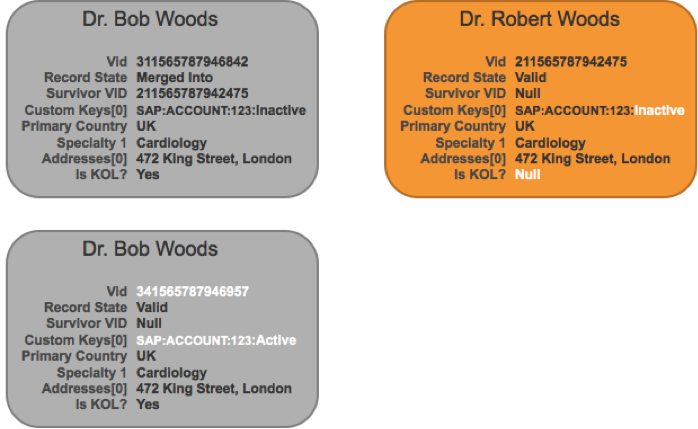Merging and unmerging records
DS
When records are merged either during a data load or manually by a data steward, information on the source records is retained for future use, such as a subsequent unmerge.
Merges
A merge operation creates a new record from multiple source records based on survivorship![]() The process by which the final record is determined as duplicate records are merged, resulting in winning and losing values. rules defined by your Administrator (which consider the source system, and individual entity and field rankings). Values from the source records are retained, while the records themselves are inactivated.
The process by which the final record is determined as duplicate records are merged, resulting in winning and losing values. rules defined by your Administrator (which consider the source system, and individual entity and field rankings). Values from the source records are retained, while the records themselves are inactivated.
The Data Lineage page for a merged record displays information on the source records that contributed to the final record.
Unmerges
An unmerge operation effectively creates new records from each of the source records that comprised the final record.
These records are considered new, independent records to downstream systems such as CRM. The influence of the unmerged source records is removed from the original record completely; related sub-objects (addresses, relationships, and licenses) move with the unmerged records.
Note: Unmerge is not a rollback or “undo” operation; The latest version of the source records is used to re-evaluate survivorship. Change requests for the original Network record are not re-applied.
Veeva OpenData records
The following apply when merging or unmerging records from Veeva OpenData:
- Local data stewards cannot request merges for Veeva-owned (orange) records.
- When locally managed (gray) and Veeva (orange) records are merged, the Veeva values (for example, first and last name) always survive.
- If a locally managed record contains information that a Veeva record does not contain (such as an address or parent HCO) that information is added to the record if the subscription that loaded the data is set to enable sub-objects. Sub-objects loaded in this way are not sent to Veeva data stewards for validation, and are not shared with other Veeva data (that is, they do not become part of Veeva data).
Merge/unmerge example
Two records are considered a match, one locally managed and one OpenData managed. They both have a record state![]() An attribute in the data model that tracks the general state of a record, for example UNDER REVIEW, VALID, INVALID, MERGED. of Valid, and have their own VIDs. The local record has a custom key, while the OpenData record does not.
An attribute in the data model that tracks the general state of a record, for example UNDER REVIEW, VALID, INVALID, MERGED. of Valid, and have their own VIDs. The local record has a custom key, while the OpenData record does not.

Upon being merged, the record state of the losing (local) record changes to Merged Into, while the record state of the winning (OpenData) record remains Valid. The local record is updated with a Survivor VID referencing the VID of the winning record, and its custom key state has been changed to Inactive.
This information appears in the data lineage![]() A detailed view of the current record, including all sources that contributed to it and survivorship results at the field level..
A detailed view of the current record, including all sources that contributed to it and survivorship results at the field level..

When these records are unmerged, a new record is created with a new VID and the original custom key of the local record. The custom key status is changed to Inactive on the Veeva owned record.
Unmerging without source keys
Depending on source system configuration, unmerging may take place without source keys being retained; for example, from CRM systems that don't otherwise support unmerge.
In these circumstances, two completely new records are created without custom keys (or any references to them). Any link to the original record is lost. For more information on configuring systems, see Adding systems.
About custom keys and VIDs
The custom key on a record is a cross reference to an external system ID, whereas a VID uniquely identifies a record within Network. Custom keys are loaded from a data source, while VIDs are generated automatically.
During a merge or unmerge, the custom key moves with its corresponding record. VIDs do not move with records; new VIDs are created during this process. Custom keys are always associated with the latest and complete Veeva OpenData record, while VIDs may be associated with out-of-date, merged, or deleted records.
Custom keys are associated with source information in the data lineage for a record.